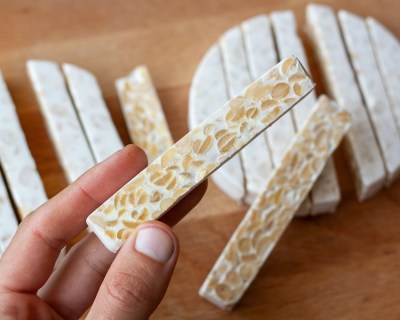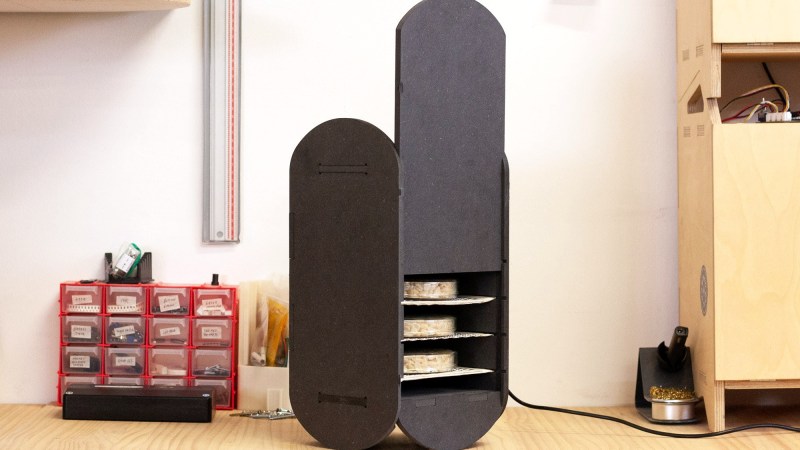[Maud Bausier] and [Antoine Jaunard] believe we should all know about tempeh — a traditional Indonesian food made out of legumes fermented with fungi. To simplify the process a bit: you get some soybeans, add a tempeh starter fungi culture to them, ferment them a while, and out comes the tempeh. It’s a great source of proteins that’s relatively easy to grow on your own. One catch, though — you do need a certain kind of climate to have it develop properly. This is why [Maud] and [Antoine] are bringing a tempeh fermenter design to this year’s Hackaday Prize.
 This fermenter’s controller drives a heating element, which adheres to a pre-programmed fermentation cycle. It also has a fan for airflow and keeping the heat uniform.
This fermenter’s controller drives a heating element, which adheres to a pre-programmed fermentation cycle. It also has a fan for airflow and keeping the heat uniform.
The fermenter itself is a small desktop machine with a laser-cut case helped by some CNC-cut and 3D-printed parts, electronics being a simple custom PCB coupling a Pi Pico with widely-available modules. This is clearly a project for someone with access to hackerspace or fab lab resources, but of course, all of the files are on GitHub.
Once built, this design allows you to grow tempeh disks in home conditions on a small scale. It seems the design is mostly finalized, but if you’d like to hear news about this project, they have a blog and a Mastodon feed with some recent updates.
We’ve covered a whole lot of fermentation-related hacks over these years. Most of them have been alcohol-related, but every now and then we see people building fermentation equipment for other food materials, like vinegar, yogurt and sourdough. Now, having seen this fermenter, we’ve learned of one more food hacking direction to explore. This project is one of 10 finalists for our latest Hackaday Prize round, Climate-Resilient Communities. It’s a well-deserved win, and we can’t wait to see where it goes!

















It’s great as an engineering project, for folks who would rather just do the fermentation, turn your oven light on and put in your beans with your starter (easy way to figure out moisture with saran wrap poked with holes).
I tried putting in the insulated delivery bags inside the oven, and it got far far too hot for fermentation: over 55+ C! So it’s definitely possible to get in the higher side of the temp range if you want to. If you want to keep temps on the lower range, wedge the door open a bit, and things just work out fine!
What does it taste similar to? Having never encountered it, having a rough idea would be helpful, as I’d be game for the build.
Tastes like a plant based cheese with light to neutral flavor of a soy product so has a wide range of meals that it goes with or can be integrated in. Hope that helps.
The consistency is rather chewy, depending on how long the beans have been left to ferment. The taste itself is very “umami” and lands on the spectrum next to french cheeses (camembert, brie). The taste is pretty unique, though, and you can use it in a lot of ways similar to tofu.
Not everyone’s cup of tea, but if you want to try, you might be able to find it in the freezer section of your local asian market.
It’s amazing! Fry it and it’s lovely and crunchy.
Tempeh is awesome and so versatile. I teach cooking and did a class on it last month. Most major grocery stores carry it, look in the refrigerated section. High in protein and fiber, grill it, chop and saute, you name it. Try steaming or marinating it before cooking.
And high in estrogen, like all soy products!
43 years of eating soybeans,and no breasts.
you’re mistaking soy for dairy milk, which actually has estrogen
I eat a lot of tempeh, love the stuff. Would be amazing to be able to ferment it at home so I’ll keep an eye on this project.
I’ve made tofu, too messy, and seitan, fun to make, but I’ve never done tempeh because one needs the culture to infect it. That always seemed more of a burden than an incubator.
Somebody pointed out an oven, I recall instructures to use a yogurt maker, so instant pots should work. An insulated box with a lightbulb also comes to mind.
The Farm Vegetarian Cookbook, actually vegan, has instructions on a lot of these things, I don’t think many were makingtempeh when it came out in the seventies.
The Book of Tempeh is also a reference, though much broader.
For anyone in the U.K., tempeh is available in Sainsburys. Go and try it! It’s amazing!
Then come back and read this with a fresh appreciation!
Argh, not meant to be a reply, sorry.
Thank you!
Come to Yogyakarta and have the best tempeh in the world
When I started to hear about syntha-meats in stores this came to mind. Fried and soy sauce drenched maybe with cheese and sprouts or greens it is a filling good sandwich.
That is SO cool. I built a crude but effective incubator — https://leisureguy.wordpress.com/2021/05/27/tempeh-incubator-4/ — and I have found that after the first 24 hours, it’s best for me to remove the tempeh (which I ferment in a Ziploc Fresh Produce bag — already perforated) and let it finish fermentation on a rack at room temperature. Generally a batch is done in 72 hours.
I like to make my own because I like to create my own combinations. Latest batch was Du Puy lentils and Kamut wheat. I use 1.5 cups of each, measured before cooking and cooked separately. Other recent batches: soybean and oat; chana dal and kamut; soybean and barley.
I make tempeh Malyasian style (bean skins left on) rather than Indonesian style (bean skins removed).
I’m making my tempeh from lupins low carb high protein but using styrofoam box with water and aquarium heater – would love an automatic tempeh maker as I need to be around to monitor and adjust temperature on my fermenter.